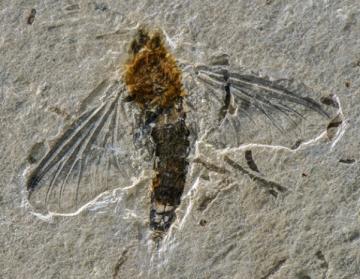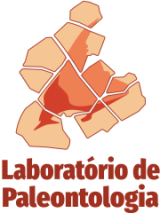A new subfamily of Ephemeroptera

The first article arising from Arianny's master thesis has just been published. Read more by clicking on the title above and click here for the publication.
Researchers from the Federal University of Espírito Santo/UFES, the Regional University of Cariri/URCA and the Federal University of Viçosa/UFV published today an article describing a new fossil of an aquatic insect found in the goelogical unit called Crato Formation, which belongs to the Araripe Basin, located on the southern region of thestate of Ceará. The publication is one of the results of the master thesis of Arianny Storari at the Graduate Program in Biological Sciences at UFES, where she currently is a doctoral candidate. The fossils belongs to the Order Ephemeroptera, also known as mayflies, which are flying insects that have short lives as adults, sometimes living up to a few minutes. During their larval stage, mayflies are aquatic.
The new fossil was excavated in the municipality of Nova Olinda by a team of paleontologists of URCA. It is an adult insect that represents, besides a new species, a new genus and also a new subfamily, given its peculiarities. The rock in which the fossil was found dates to the Lower Cretaceous, between 113 and 125 million years ago, when Africa and South America were still separating from each other. The fossil, which belongs to the family Oligoneuriidae, was named Incogemina nubila, meaning incomplete gemination in latin and referring to the pattern of its wing veins. The term nubila means cloudy, given the grey color of the limestone in which the fossil was preserved. According to the entomologist Frederico Salles, "The distribution of the wing veins of Incogemina combines a pattern in which some longitudinal veins tend to unite, as in most species of the family Oligoneuriidae, and an ancestral pattern, typical of all other mayflies. This is the main character that makes this a unique species".
Fossils of this order of aquatic insects are abundant in the Crato Formation, but those that belong to the family Oligoneuriidae, in particular, are quite rare. This is only the second fossil of an adult of this family ever found, and the researchers observed that another fossil, that was reported previously in the literature, also represents the species Incogemina nubila. "One of the explications for the rarity of fossils of this group is their life habits. During the larval stage, most Oligoneuriidae larvae live in environments with running water. This type of environment is not favorable to the preservation of such delicate insects, as the currents would destroy their more delicate parts, precluding fossilization", explains the researcher Arianny Storari.
Paleontologist Taissa Rodrigues highlights that the specimen upon which Incogemina nubila was based is one of the few fossils from the Araripe Basin whose exact provenance is known. "Although other mayfly species are known from this fossiliferous unit, they were collected informally, and there is no information on their locality data. As we know the place where Incogemina nubila was found, it is possible to plan more excavations to look for more fossils of this rare species".
"Now that the first controlled excavation on the Crato Formation was done by the team of the Paleontology Lab of URCA, new information on the evolution of mayflies will certainly arise, besides data on the past environments of the Crato Formation, an area of intense exploitation of laminated limestone", explains paleontologist Álamo Saraiva. Information from the analysis of these abundant specimens can bring information on the environment in which this paleovbiota lived, and even about climatic stresses that they might have experienced, especially the aquatic larvae. Nowadays, many species of the group are considered important water quality bioindicators, since they are sensible to the variations of the environment where they live.

